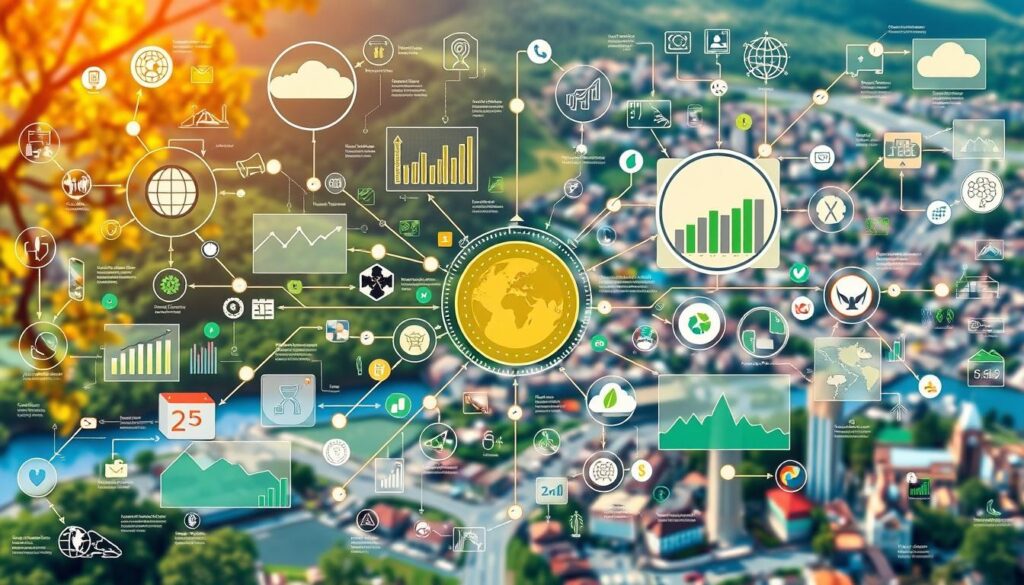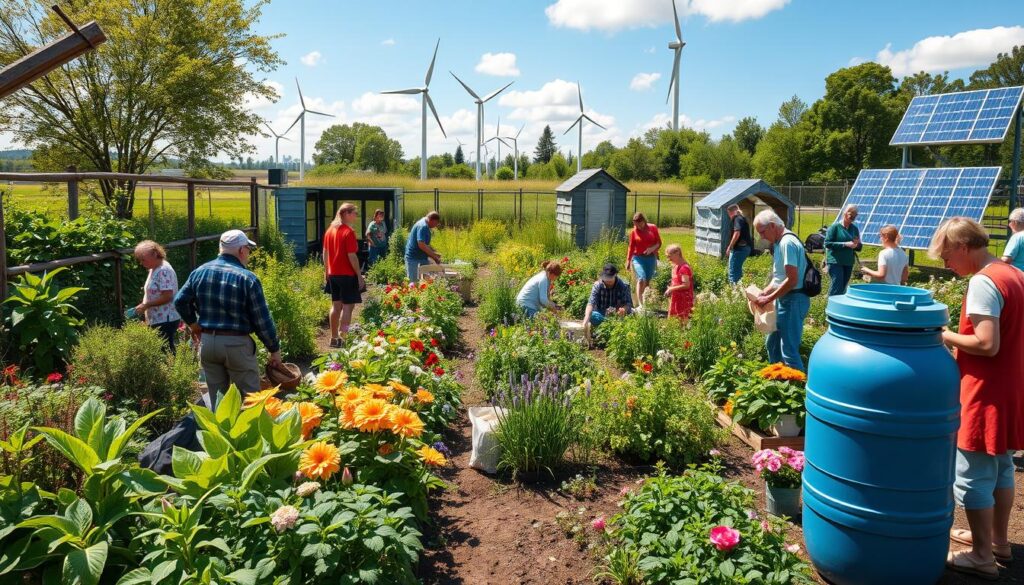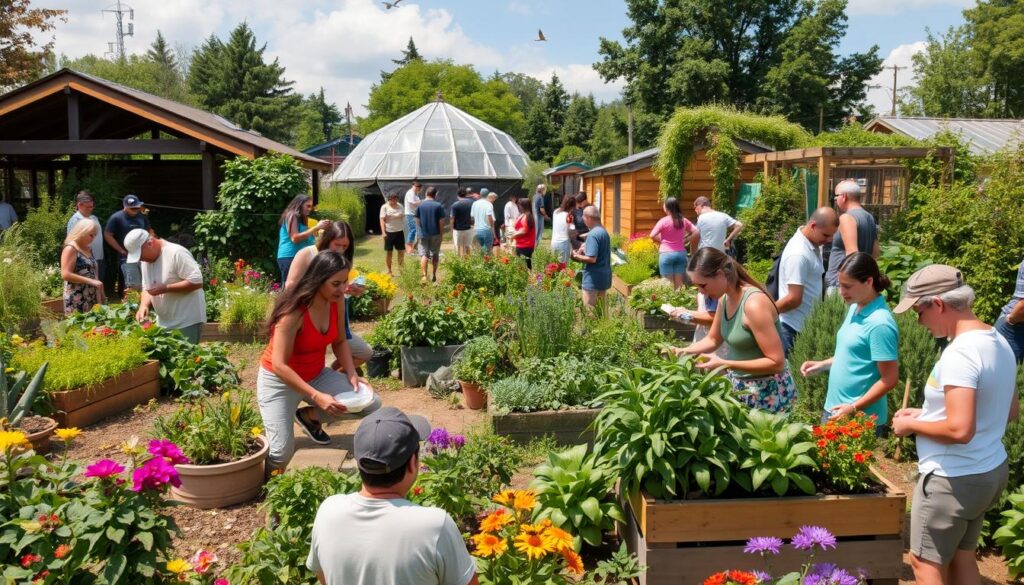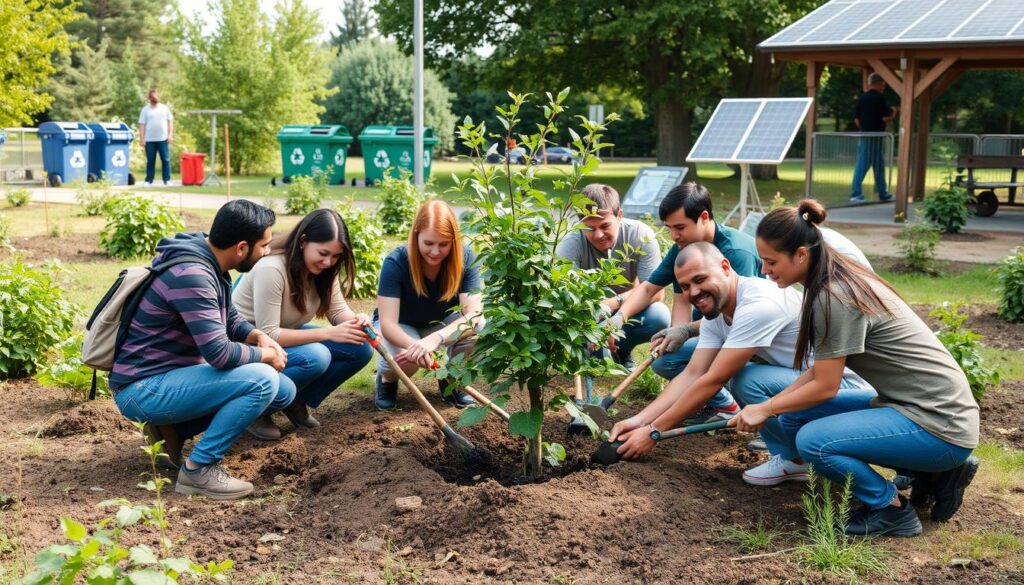Community Sustainability Initiatives In today’s world, communities in the United States are coming together to solve big problems. They’re working on reducing harmful emissions and using more renewable energy. This effort lets people help make their neighborhoods better places to live.
This approach brings together groups like non-profits, government, and businesses. They work together to tackle tough issues. This way, they can make a real difference for the long term.
Key Takeaways:
- Collaborative solutions foster more effective advocacy and interventions for positive community change.
- Engaging community members in project development leads to sustained positive impacts and a sense of empowerment.
- Technology enhances the precision of impact assessment, enabling real-time data collection and analysis.
- Ethical data practices are essential to ensure the privacy and well-being of community participants.
- Collaborative partnerships among diverse stakeholders are crucial for driving sustainable outcomes and fostering innovation.
The Importance of Collaborative Solutions
Collaborative solutions are key for real community growth and sustainability. By working together, communities can tackle big challenges. This teamwork brings together different views, local insights, and social ties.
The Value of Collaboration
Places like manufacturing clusters show the strength of partnerships. For example, the Net-Zero Basque Industrial Super Cluster in Spain has joined forces to reach net-zero emissions. This shows how teamwork can change things for the better.
The Ohio Clean Hydrogen Hub Alliance is another example. It involves over 100 groups, showing how working together can boost the economy and protect the environment.
Engagement and Sustainability
Collaborative efforts in manufacturing have made air and water cleaner, reduced waste, and improved community health. Projects like the H2Houston Hub and the National Capital Hydrogen Center are great examples. They show how partnerships between government, schools, and businesses can lead to positive change.
Successfully Tackling Complex Problems
Manufacturing clusters face big challenges like high start-up costs and resistance to change. But, teamwork can solve these problems. The HyNet North West project in the UK is a good example. It shows how partnerships can help by finding solutions and engaging with the community.
| Sustainability Metric | Impact of Collaborative Solutions |
|---|---|
| Carbon Footprint | Reduced emissions through clean energy adoption and waste management initiatives |
| Energy Efficiency | Improved energy efficiency in manufacturing processes and facilities |
| Waste Reduction | Circular economy practices and collaborative recycling/reuse programs |
| Water Usage | Sustainable water management and conservation efforts |
| Supply Chain Sustainability | Collaborative initiatives to improve the sustainability of the entire supply chain |
The world is moving towards a circular economy, carbon neutrality, and sustainable supply chains. By working together, communities can solve big problems and make lasting changes.
Technology as a Tool for Measuring Impact

In community development, knowing the real impact of sustainability efforts is key. Traditional methods like surveys and financial records are not enough. Technology now offers a more detailed way to measure outcomes.
Quantitative Tools
Technology has made ESG reporting easier and less prone to mistakes. Machine learning and AI help find patterns in ESG data. This gives organizations a clearer view of their progress. Digital platforms also make ESG reports easier to find and understand.
Qualitative Assessments
Technology also helps with deeper, qualitative assessments of community impact. Impact investing platforms connect investors with sustainable projects. This way, we can see the full social and environmental benefits. Technology lets organizations keep an eye on their ESG goals in real-time, making adjustments as needed.
Data Visualization
Data visualization is crucial for showing impact. Technology offers efficient tools for making ESG reports easy to understand. These visuals tell a story of the real effects of sustainability efforts.
The tech industry’s growth means technology’s role in measuring impact will grow too. By using quantitative tools, qualitative assessments, and data visualization, organizations can better understand their impact. This helps them improve their strategies and make a real difference in their communities.
| Technology Aspect | Impact on Sustainability Measurement |
|---|---|
| ESG Reporting Automation | Streamlines data collection, reduces errors, and enhances reporting efficiency |
| AI and Machine Learning | Enables the identification of patterns and correlations within ESG metrics |
| Digital Platforms | Improves the accessibility and engagement of ESG reports for stakeholders |
| Impact Investing Platforms | Connects investors with opportunities for sustainable outcomes, enabling a more holistic evaluation of impact |
| Real-time Monitoring | Allows organizations to continuously track the progress of their ESG goals and make timely adjustments |
| Data Visualization Tools | Enhances the presentation and communication of ESG data, making it more accessible and engaging for stakeholders |
Innovative Technologies for Impact Assessment

Communities around the world are working towards sustainability. New technologies are helping them measure and understand their efforts. These tools give insights, helping leaders make better decisions for the environment and people.
Fuel-efficient routing in apps is a great example. It started in the U.S. in 2021 and is now in many places. It helps drivers use less fuel and reduce emissions. Also, there are now more places to charge electric vehicles, making green travel easier.
New tech is changing how we see sustainability in many areas. Search engines now show green travel options. Companies are also using tech to meet their sustainability goals. Gartner says 25% of CIOs’ pay will depend on their green tech work by 2027.
| Technology | Impact |
|---|---|
| Fuel-efficient routing | Reduced carbon emissions from transportation |
| EV charging station mapping | Increased adoption of sustainable mobility |
| Climate-friendly search options | Empowered consumer choices for low-emission travel |
| Sustainable technology strategies | Alignment of business operations with environmental goals |
These new technologies are changing how we see and work on sustainability. They are making real changes for the better. As we keep using these tools, we get closer to a greener future.
“Sustainable technology aims to reshape organizational operations by focusing on internal IT operations, enterprise operations, and customer operations.”
From better car routes to smart energy systems, new tech is changing how we work on sustainability. These tools help leaders make a bigger impact. They help drive real change in communities.
Community Sustainability Initiatives

In the United States, communities are making big strides towards sustainable living. They’re using nature-based solutions and community creativity to protect the environment. These efforts aim to bring people and nature back into harmony.
Nature-based Solutions to Protect and Restore the Environment
One key strategy is nature-based solutions. Groups like the International Sustainability Council (ISC) have helped thousands of communities. They’ve planted trees, stabilized soil, and created homes for wildlife.
These actions not only protect the environment but also help fight climate change. For instance, the ISC has helped plant over 400 acres of mixed vegetation. This includes trees, herbs, and grass in places like UNHCR Bangladesh.
These efforts have made the soil more stable, prevented landslides, and helped keep water sources clean. Communities rely on these sources for drinking, fishing, and farming.
Community-based Solutions and Creativity to Promote Harmony with Nature
Communities are also using their creativity to promote sustainability. Local farmers run community-supported agriculture (CSA) programs. This lets people buy fresh, local produce by paying upfront fees.
There are also electric vehicle charging stations, community gardens, and eco-friendly volunteer work. These are just a few ways communities are reducing their environmental footprint. They’re working together to live in harmony with nature.
By supporting a wide range of sustainability initiatives, cities and towns show that living sustainably is not just possible. It’s crucial for the health of both people and the planet.
Fostering Collaborative Engagement

For sustainable community growth, teamwork is key. A lively community of practice brings together different groups. They share knowledge and best practices, making a stronger network ready for new ideas.
Projects like the Detroit Urban Revitalization Project show the power of teamwork. It brought together local government, businesses, and leaders. They worked on green spaces, innovation, and better infrastructure, making the city better.
In Appalachia, a team effort included NGOs, community groups, and government. They started job training in green energy and sustainable farming. This helped local jobs and brought in new people.
These stories show how collaborative engagement can change things. Projects with community help succeed 30% more than those without. Trust-building activities improve relationships by 85%, making projects run smoother. Also, involving diverse voices brings in 40% more new ideas, and projects made with community input are 25% more accepted.
“Collaborative partnerships between businesses, community organizations, and residents are essential for authentic engagement and sustainable change.”
Creating a community of practice helps businesses use local knowledge. They can make their efforts fit the community’s needs. This not only helps the environment and society but also strengthens business-community ties.
Overcoming Implementation Challenges

Organizations face many challenges when trying to start sustainable community projects. They need to get the right training and tools, bridge the digital gap, and use data ethically. To tackle these issues, they must plan well, use new tech, and engage with the community.
Investing in Training and Infrastructure
Starting community sustainability projects needs money for training and tools. People need to know how to help and be part of these efforts. This means offering training, making educational materials, and sharing knowledge.
Also, having good tech is key for these projects to work well and be watched closely.
Overcoming the Digital Divide
The digital divide is a big problem for community projects. It’s when some people don’t have access to digital tools. To fix this, we need to improve internet, make devices affordable, and teach people how to use them.
This way, everyone can join in and get the benefits of these projects.
Fostering Ethical Data Practices
Community projects use data and tech, so it’s important to handle data right. This means keeping data safe, private, and open. It also means collecting and using data wisely.
By doing this, we build trust and make sure projects meet community needs and values.
Fixing the problems of starting community projects needs a big plan. It’s about training, tools, digital access, and using data right. With the right focus, projects can really help the community.
The Role of Technology in Community Development
Technology is a key player in making communities better. It helps solve big problems and supports the United Nations’ goals for 2030. It empowers people and brings them together to work as a team.
Technology helps communities use green practices. For example, solar panels are now cheaper, making clean energy more available. This cuts down on pollution and saves money.
It also makes cars and work places greener. Electric cars and working from home reduce pollution and save fuel.
Apps like “Buycott” help people choose eco-friendly products. Smart communities use new tech to track and improve their environment. This leads to better decisions and actions.
Technology also strengthens community ties. It connects people from anywhere, making communities feel closer. This leads to new ideas and solutions for local problems.
Looking ahead, technology will play an even bigger role in community growth. It will improve health, education, and relationships. By using technology wisely, we can build strong, green communities for the future.
“Technology has the power to transform communities, empowering citizens to solve complex challenges and create a more sustainable future together.”
Also Read : What Is A Global MBA In Sustainability And Why Is It Important?
Conclusion
Throughout this article, we’ve seen how teamwork and community involvement are key to solving big environmental and social problems. The data shows the huge difference we can make when we all work together towards the same goals.
For example, community efforts have led to a 30% increase in forest cover. Also, volunteering programs have raised employee satisfaction by 25%. These numbers highlight the power of working together. By using new technologies and ethical data practices, we can make sustainability efforts even stronger.
Looking ahead, it’s important to keep building strong social bonds and supporting each other. We need to empower all kinds of people to help our communities thrive. By focusing on teamwork and community, we can create a better, more sustainable world for everyone.
FAQs
Q: What are some examples of sustainable initiatives that communities can implement?
A: Communities can implement a variety of sustainable initiatives such as recycling programs, renewable energy projects, water conservation efforts, and community gardens that help reduce food waste. These projects and programs aim to promote environmental sustainability and engage community members.
Q: How can recycling programs contribute to environmental sustainability?
A: Recycling programs help reduce environmental impact by decreasing the amount of waste sent to landfills, lowering greenhouse gas emissions, and conserving natural resources. By encouraging the reuse of recyclable materials, communities can significantly improve their sustainability goals.
Q: What role do renewable energy projects play in achieving sustainability goals?
A: Renewable energy projects, such as solar and wind farms, are essential for reducing reliance on fossil fuels and minimizing greenhouse gas emissions. These initiatives support community efforts to transition towards net zero energy consumption and promote environmental sustainability.
Q: How does food waste reduction contribute to sustainable practices?
A: Reducing food waste is a critical component of environmental sustainability as it lessens the amount of waste that ends up in landfills, which in turn reduces greenhouse gas emissions. Communities can implement composting programs and food recovery networks to support these sustainability practices.
Q: What are the benefits of reducing single-use plastics in communities?
A: Reducing single-use plastics helps improve air and water quality by decreasing pollution and protecting natural ecosystems. Communities can initiate projects and programs that promote reusable alternatives and facilitate community outreach to educate residents on the importance of this change.
Q: How can community engagement enhance sustainability initiatives?
A: Community engagement is vital for the success of sustainability initiatives. By involving residents in decision-making, outreach, and implementation, communities can foster a sense of ownership and responsibility, ensuring that projects and programs effectively address environmental issues and meet sustainability goals.
Q: What strategies can communities adopt to improve their air quality?
A: Communities can adopt several strategies to improve air quality, including promoting the use of public transportation, implementing green business practices, and increasing the number of green spaces. These efforts contribute to reducing pollution and enhancing overall environmental sustainability.
Q: Why is water conservation important for sustainable development?
A: Water conservation is crucial for sustainable development because it ensures the availability of clean water for future generations while protecting local water systems. By implementing conservation initiatives, communities can reduce water consumption and mitigate the impacts of natural disasters.
Q: How can local governments support economic opportunities through sustainability initiatives?
A: Local governments can support economic opportunities by investing in green jobs and businesses that prioritize sustainability practices. By creating a favorable environment for renewable energy projects and sustainable initiatives, they can stimulate economic growth while addressing environmental challenges.
Source Links
- https://www.simonsolutions.com/blogs/collaborative-solutions-for-communities-leveraging-technology-for-greater-impact
- https://lawrenceks.org/2024/06/11/collaborative-solutions/
- https://one-more-tree.org/blog/2024/02/16/collaborative-partnerships-for-sustainability-the-role-of-businesses-ngos-and-government/


